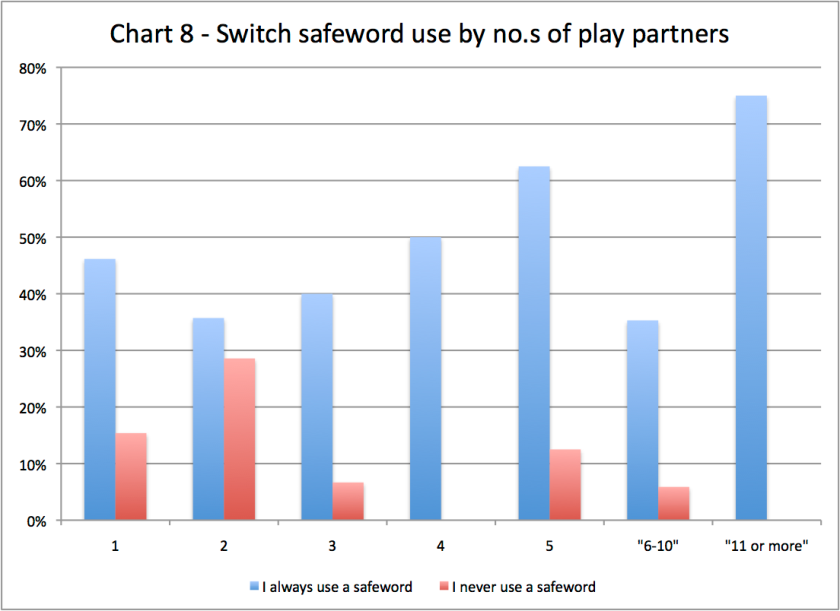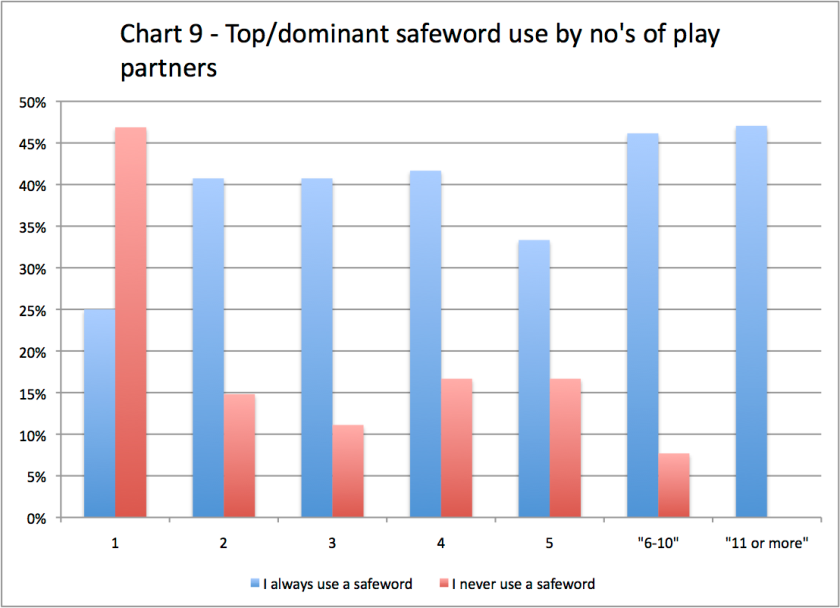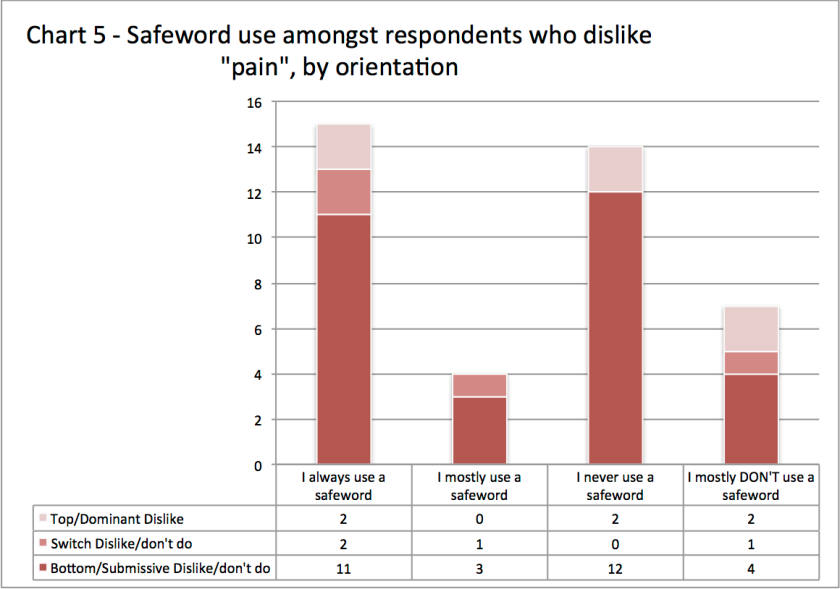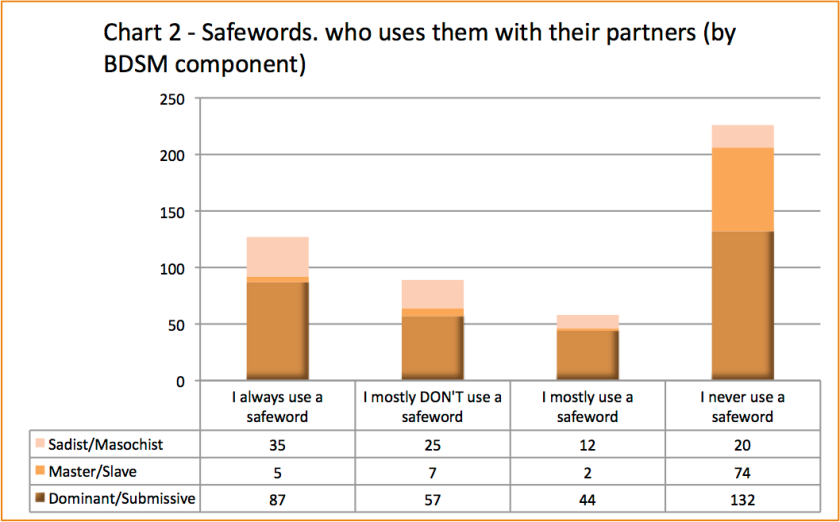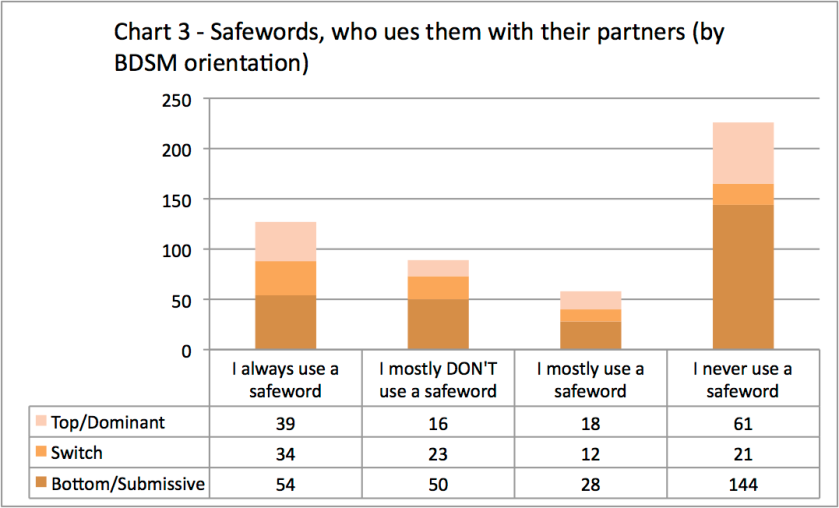This article looks at how people who answered the safeword survey said they used safewords and whether this differed for older or younger respondents.
It does. There are large variations according to age and also dependant on whether the BDSM interaction is with a relationship partner or a play partner.
The survey, of course, isn’t representative of anything except the views of people who took part. It’s important to note that some of the age groups are quite small. There were only eight people aged 18-20 (all were women) and four over 70 (all men). The other groups ranged in size from 77 to 148 so are more likely to reflect a spread of opinion (496 of the 533 people in the sample answered the question).
Only 18-20 year olds were more likely to use safewords with both relationship partners and with pay partners.
Over all the age groups, when it came to relationship partners, every group except the 18-20s said they were more likely not to use safewords (other than people of 70 or older where the decision was split 50-50).
When it comes to BDSM interactions with play partners, five of the seven age groups said they were more likely to use safe words than not. The two age-groups that said they were less likely to use safewords (21-29 and 30-39 year olds) only did so by a margin of two or three per cent.
Data for this article
The data for this article was compiled from that contained in the table below.
| Thinking of BDSM interactions with your principal relationship partner(s) and safewords… | ||||||
| Which category below includes your age? | I always use a safeword | I mostly use a safeword | I mostly DON’T use a safeword | I never use a safeword | Grand Total | |
| Female | 18-20 | 6 | 1 | 1 | 8 | |
| 21-29 | 10 | 7 | 6 | 27 | 50 | |
| 30-39 | 22 | 5 | 20 | 46 | 93 | |
| 40-49 | 21 | 10 | 19 | 46 | 96 | |
| 50-59 | 9 | 4 | 7 | 19 | 39 | |
| 60-69 | 2 | 1 | 2 | 2 | 7 | |
| Female Total | 70 | 28 | 54 | 141 | 293 | |
| Male | 21-29 | 8 | 2 | 2 | 10 | 22 |
| 30-39 | 12 | 8 | 12 | 15 | 47 | |
| 40-49 | 12 | 9 | 4 | 30 | 55 | |
| 50-59 | 13 | 6 | 11 | 23 | 53 | |
| 60-69 | 8 | 3 | 3 | 4 | 18 | |
| 70 or older | 1 | 1 | 1 | 1 | 4 | |
| Male Total | 54 | 29 | 33 | 83 | 199 | |
| Grand Total | 124 | 57 | 87 | 224 | 492 | |
| Thinking of BDSM interactions with play partners and safewords… | ||||||
| Which category below includes your age? | I always use a safeword | I mostly use a safeword | I mostly DON’T use a safeword | I never use a safeword | Grand Total | |
| Female | 18-20 | 6 | 2 | 8 | ||
| 21-29 | 15 | 5 | 14 | 16 | 50 | |
| 30-39 | 28 | 14 | 25 | 26 | 93 | |
| 40-49 | 36 | 13 | 19 | 28 | 96 | |
| 50-59 | 13 | 6 | 9 | 11 | 39 | |
| 60-69 | 2 | 2 | 1 | 2 | 7 | |
| Female Total | 100 | 40 | 70 | 83 | 293 | |
| Male | 21-29 | 9 | 7 | 3 | 3 | 22 |
| 30-39 | 14 | 13 | 13 | 7 | 47 | |
| 40-49 | 15 | 12 | 11 | 17 | 55 | |
| 50-59 | 18 | 7 | 14 | 14 | 53 | |
| 60-69 | 10 | 3 | 3 | 2 | 18 | |
| 70 or older | 2 | 1 | 1 | 4 | ||
| Male Total | 68 | 43 | 45 | 43 | 199 | |
| Grand Total | 168 | 83 | 115 | 126 | 492 | |
Background
This is the third article about the safeword survey I recently conducted. More information about the terms and ideas I use in these surveys can be found here. Information about the demographics of this survey is here.
This article can be compared with an earlier one, looking at how people use safewords with their principal relationship partners.
Related articles
- Safeword Survey – who uses them with their principal partners (belasarius.com)
- BDSM People who like “pain” and safewords (belasarius.com)
- Safewords – new, more detailed poll – Please take part (belasarius.com)
- What is BDSM? (kinxfetish.wordpress.com)
- One In Three Kinksters Reports A Consent Violation (yesmeansyesblog.wordpress.com)





